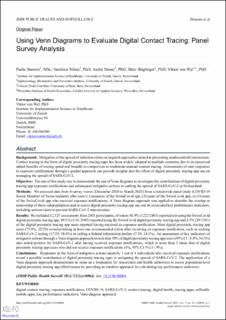Please use this identifier to cite or link to this item:
https://doi.org/10.21256/zhaw-23781Full metadata record
| DC Field | Value | Language |
|---|---|---|
| dc.contributor.author | Daniore, Paola | - |
| dc.contributor.author | Nittas, Vasileios | - |
| dc.contributor.author | Moser, André | - |
| dc.contributor.author | Höglinger, Marc | - |
| dc.contributor.author | von Wyl, Viktor | - |
| dc.date.accessioned | 2021-12-20T09:56:14Z | - |
| dc.date.available | 2021-12-20T09:56:14Z | - |
| dc.date.issued | 2021 | - |
| dc.identifier.issn | 2369-2960 | de_CH |
| dc.identifier.uri | https://digitalcollection.zhaw.ch/handle/11475/23781 | - |
| dc.description.abstract | Background: Mitigation of the spread of infection relies on targeted approaches aimed at preventing nonhousehold interactions. Contact tracing in the form of digital proximity tracing apps has been widely adopted in multiple countries due to its perceived added benefits of tracing speed and breadth in comparison to traditional manual contact tracing. Assessments of user responses to exposure notifications through a guided approach can provide insights into the effect of digital proximity tracing app use on managing the spread of SARS-CoV-2. Objective: The aim of this study was to demonstrate the use of Venn diagrams to investigate the contributions of digital proximity tracing app exposure notifications and subsequent mitigative actions in curbing the spread of SARS-CoV-2 in Switzerland. Methods: We assessed data from 4 survey waves (December 2020 to March 2021) from a nationwide panel study (COVID-19 Social Monitor) of Swiss residents who were (1) nonusers of the SwissCovid app, (2) users of the SwissCovid app, or (3) users of the SwissCovid app who received exposure notifications. A Venn diagram approach was applied to describe the overlap or nonoverlap of these subpopulations and to assess digital proximity tracing app use and its associated key performance indicators, including actions taken to prevent SARS-CoV-2 transmission. Results: We included 12,525 assessments from 2403 participants, of whom 50.9% (1222/2403) reported not using the SwissCovid digital proximity tracing app, 49.1% (1181/2403) reported using the SwissCovid digital proximity tracing app and 2.5% (29/1181) of the digital proximity tracing app users reported having received an exposure notification. Most digital proximity tracing app users (75.9%, 22/29) revealed taking at least one recommended action after receiving an exposure notification, such as seeking SARS-CoV-2 testing (17/29, 58.6%) or calling a federal information hotline (7/29, 24.1%). An assessment of key indicators of mitigative actions through a Venn diagram approach reveals that 30% of digital proximity tracing app users (95% CI 11.9%-54.3%) also tested positive for SARS-CoV-2 after having received exposure notifications, which is more than 3 times that of digital proximity tracing app users who did not receive exposure notifications (8%, 95% CI 5%-11.9%). Conclusions: Responses in the form of mitigative actions taken by 3 out of 4 individuals who received exposure notifications reveal a possible contribution of digital proximity tracing apps in mitigating the spread of SARS-CoV-2. The application of a Venn diagram approach demonstrates its value as a foundation for researchers and health authorities to assess population-level digital proximity tracing app effectiveness by providing an intuitive approach for calculating key performance indicators. | de_CH |
| dc.language.iso | en | de_CH |
| dc.publisher | JMIR Publications | de_CH |
| dc.relation.ispartof | JMIR Public Health and Surveillance | de_CH |
| dc.rights | https://creativecommons.org/licenses/by/4.0/ | de_CH |
| dc.subject | COVID-19 | de_CH |
| dc.subject | SARS-CoV-2 | de_CH |
| dc.subject | Venn diagram approach | de_CH |
| dc.subject | Contact tracing | de_CH |
| dc.subject.ddc | 614: Public Health und Gesundheitsförderung | de_CH |
| dc.title | Using venn diagrams to evaluate digital contact tracing : panel survey analysis | de_CH |
| dc.type | Beitrag in wissenschaftlicher Zeitschrift | de_CH |
| dcterms.type | Text | de_CH |
| zhaw.departement | School of Management and Law | de_CH |
| zhaw.organisationalunit | Winterthurer Institut für Gesundheitsökonomie (WIG) | de_CH |
| dc.identifier.doi | 10.2196/30004 | de_CH |
| dc.identifier.doi | 10.21256/zhaw-23781 | - |
| dc.identifier.pmid | 34874890 | de_CH |
| zhaw.funding.eu | No | de_CH |
| zhaw.issue | 12 | de_CH |
| zhaw.originated.zhaw | Yes | de_CH |
| zhaw.publication.status | publishedVersion | de_CH |
| zhaw.volume | 7 | de_CH |
| zhaw.publication.review | Peer review (Publikation) | de_CH |
| zhaw.funding.zhaw | COVID-19 Social Monitor | de_CH |
| zhaw.author.additional | No | de_CH |
| zhaw.display.portrait | Yes | de_CH |
| Appears in collections: | Publikationen School of Management and Law | |
Files in This Item:
| File | Description | Size | Format | |
|---|---|---|---|---|
| 2021_Daniore_Using_Venn_Diagrams_to_Evaluate_Digital_Contact_Tracing.pdf | 1.09 MB | Adobe PDF |  View/Open |
Show simple item record
Daniore, P., Nittas, V., Moser, A., Höglinger, M., & von Wyl, V. (2021). Using venn diagrams to evaluate digital contact tracing : panel survey analysis. JMIR Public Health and Surveillance, 7(12). https://doi.org/10.2196/30004
Daniore, P. et al. (2021) ‘Using venn diagrams to evaluate digital contact tracing : panel survey analysis’, JMIR Public Health and Surveillance, 7(12). Available at: https://doi.org/10.2196/30004.
P. Daniore, V. Nittas, A. Moser, M. Höglinger, and V. von Wyl, “Using venn diagrams to evaluate digital contact tracing : panel survey analysis,” JMIR Public Health and Surveillance, vol. 7, no. 12, 2021, doi: 10.2196/30004.
DANIORE, Paola, Vasileios NITTAS, André MOSER, Marc HÖGLINGER und Viktor VON WYL, 2021. Using venn diagrams to evaluate digital contact tracing : panel survey analysis. JMIR Public Health and Surveillance. 2021. Bd. 7, Nr. 12. DOI 10.2196/30004
Daniore, Paola, Vasileios Nittas, André Moser, Marc Höglinger, and Viktor von Wyl. 2021. “Using Venn Diagrams to Evaluate Digital Contact Tracing : Panel Survey Analysis.” JMIR Public Health and Surveillance 7 (12). https://doi.org/10.2196/30004.
Daniore, Paola, et al. “Using Venn Diagrams to Evaluate Digital Contact Tracing : Panel Survey Analysis.” JMIR Public Health and Surveillance, vol. 7, no. 12, 2021, https://doi.org/10.2196/30004.
Items in DSpace are protected by copyright, with all rights reserved, unless otherwise indicated.